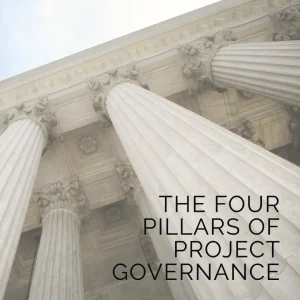To find out how Artificial Intelligence is changing the Project Management landscape, you may enjoy reading this article https://www.shaunstoltz.com/did-artificial-intelligence-just-change-everything-about-project-management/
I Introduction
Hello, and welcome, fellow project management enthusiast! Today, we’re about to embark on a fascinating journey into the world of program management. This is a world that might seem filled with technical jargon and complex concepts at first glance, but stick with me, and I promise to make it as simple and engaging as possible.
If you’ve stumbled onto this post, chances are you’re new to program management. Perhaps you’re a project manager looking to level up your skills or maybe an ambitious professional eager to understand how the big-picture stuff works in your company. Or, it could be that you’re simply curious, hungry for knowledge, and looking to expand your horizons. Whoever you are, and whatever brought you here, I assure you, you’re in the right place.
Program management is like a master conductor leading a symphony of projects, ensuring they all work harmoniously towards the same strategic goals. It’s a critical element in businesses, particularly those that juggle multiple projects concurrently. It allows organizations to achieve their strategic objectives more efficiently, aligning numerous projects to work in harmony and steering them towards a common goal.
So, whether you’re a fresh-faced newcomer to the field or a seasoned professional seeking a refresher, this blog post is for you. In the following sections, we’ll be breaking down the complex world of program management into bite-sized, digestible pieces. You’ll learn what it is, why it’s so crucial, how it’s implemented, and a lot more.
So, let’s roll up our sleeves and dive into the world of program management together. It’s going to be a thrilling ride, and I can’t wait to explore it with you. Let’s go!
II What is Program Management?
Alright, now that we’ve warmed up, let’s get into the meat of the matter. What exactly is program management? To put it simply, program management is the art and science of coordinating multiple related projects to deliver benefits that would not be possible if the projects were managed independently.
Remember, a program is essentially a group of related projects. Imagine a set of gears in a machine, each one unique yet essential, spinning in tandem to drive the machine forward. That’s how projects function within a program, each with its own scope, team, and objectives, but all aligning under a broader goal.
Now, if you’re familiar with project management, you might be asking, “Isn’t this just like managing a bunch of projects?” Well, not quite. While project management focuses on the successful completion of individual projects, program management has a wider lens. It’s about making sure all these projects are working together effectively towards the organization’s strategic goals.
Let’s use an analogy to make this clearer. If managing a project is like piloting a boat – ensuring it reaches its destination safely and on time – then managing a program is like overseeing a fleet of boats. You’re not just concerned with each boat reaching its destination. You’re also ensuring they navigate their routes in a coordinated, strategic manner, all while managing resources, mitigating risks, and maintaining communication across the entire fleet.
Getting a grip on the difference between project and program management is crucial. It helps you understand the breadth and depth of a program manager’s role – but we’ll delve deeper into that in the next sections.
By now, you should have a fundamental understanding of what program management is. But don’t worry if it’s not all crystal clear yet. As we navigate through the components, roles, benefits, and steps of program management, you’ll get a more vivid picture.
Ready to delve deeper into this captivating world? Fantastic! Onward we go.
III Key Components of Program Management
We’ve made it to the heart of our journey, where we’ll be dissecting the key components of program management. Think of these as the building blocks, the fundamental elements that breathe life into program management.
Program Charter
First on the list is the program charter. This is like the blueprint of your program. It outlines the program’s vision, objectives, and scope. Just like a ship needs a compass to navigate the vast seas, your program needs a charter to guide it towards its goals.
Program Plan
Next up, we have the program plan, which is your roadmap. It’s like the GPS that provides turn-by-turn directions to your destination. The program plan outlines the strategy for achieving the objectives set out in the charter, including scheduling, budgeting, and resource allocation.
Program Infrastructure
Then there’s the program infrastructure. If your program was a car, this would be the engine under the hood. The program infrastructure includes the processes, systems, and tools that keep your program running smoothly.
Program Governance
Program governance, on the other hand, is the steering wheel. It provides direction and control, ensuring that the program stays on track and aligned with the organization’s strategic objectives. Governance involves setting up decision-making frameworks and ensuring accountability at all levels.
Program Management Office (PMO)
Now, let’s talk about the program management office, or PMO. The PMO is like the control tower at an airport, overseeing all the operations and making sure everything runs like clockwork. It provides support, guidance, and oversight for all the projects within the program.
Risk Management
Last, but certainly not least, is risk management. Navigating the world of program management without considering risk is like sailing into a storm without a plan. Risk management is essential to anticipate, evaluate, and mitigate any potential obstacles that could derail your program.
Phew! That’s quite a list, isn’t it? But don’t worry, each of these components plays a vital role in making your program a success. As you gain more familiarity with them, you’ll find they’re not as daunting as they first appear.
In our next section, we’ll look at the roles and responsibilities within program management. So, let’s keep this momentum going and dive right in!
IV Roles and Responsibilities in Program Management
Welcome back, explorer! Now that we’ve covered the key components of program management, it’s time to meet the key players in this exciting field. In this section, we’ll discuss who does what in the world of program management.
The Program Manager
At the helm of our ship, we have the program manager. This individual is a maestro, orchestrating the various elements of the program to create a beautiful symphony of success. The program manager is responsible for planning and executing the program, coordinating with project managers, managing stakeholders, and ensuring that the program’s goals align with the company’s strategic objectives.
It’s a role that requires strong leadership skills, excellent communication, and a knack for strategic thinking. If program management were a chess game, the program manager would be the one carefully planning moves, anticipating challenges, and leading the team to victory.
Stakeholders
But a program manager doesn’t operate in a vacuum. They work closely with various stakeholders, individuals, or groups who have an interest in the program’s outcome. Stakeholders can include team members, executives, clients, and even end users.
Each stakeholder plays a critical role in program success. They provide valuable input, support, and resources. They’re also the ones who will evaluate the success of the program, so keeping them engaged and informed is crucial.
There you have it – the main characters in our program management story. But remember, while these roles are critical, they’re part of a larger team. It’s the collaborative effort of everyone involved that drives a program towards its goals.
As we move forward, we’ll be diving into the benefits of program management, which will help you understand why all of this is so important. So stay tuned and keep that explorer spirit alive! We’re just getting to the good part!
V Benefits of Program Management
Hello again, fellow adventurer! I hope you’re enjoying our journey so far through the terrain of program management. We’ve covered quite a bit of ground, haven’t we? By now, you might be wondering, “What’s in it for me?” or “Why is all this important?” Well, I’m glad you asked! In this section, we’re going to explore the real treasure of our journey: the benefits of program management.
Aligning Projects with Business Strategy
First and foremost, program management helps align projects with the overall business strategy. Imagine a rowing team where everyone has their own idea of which direction to go. They might be giving their all, but the boat just won’t move efficiently. Now, picture a team where everyone rows in the same direction, with the same rhythm. That’s the power of alignment!
Program management ensures all projects within a program are rowing in the same direction, each contributing to the strategic goals of the organization. It’s about making sure your efforts aren’t just creating ripples, but making waves!
Resource Optimization
Next up, we have resource optimization. In any project, resources like time, money, and talent are precious commodities. Without proper management, they can easily be wasted, leading to inefficiency and frustration.
Program management, with its bird’s-eye view, helps ensure that resources are used efficiently across all projects. It’s like having a master chef in the kitchen, making sure every ingredient is used wisely and no resource is left to spoil.
Better Control and Risk Management
Lastly, program management provides better control and risk management. It’s like having a high-tech security system that not only monitors for intruders but also predicts potential threats and mitigates them proactively.
Through effective program management, potential risks can be identified early, plans can be adjusted accordingly, and disaster can be averted.
So there you have it, the treasure trove of benefits that program management brings! But remember, like any treasure, these benefits aren’t just lying around for anyone to grab. They require skill, dedication, and the right steps to unlock.
Speaking of steps, in the next section, we’re going to look at how to implement program management. So, ready to take this journey to the next level? Let’s go!
VI Steps to Implementing Program Management
Welcome back, intrepid explorer! We’ve charted the waters of program management, identified the key players, and discovered the treasure trove of benefits it offers. Now, it’s time to set sail and put all this knowledge into action. In this section, we’ll go through the steps to implementing program management. Buckle up – it’s time to set our course!
Step 1: Define Your Program
Our first step on this voyage is defining your program. This is where you’ll decide the strategic goals your program is aiming to achieve. Remember the program charter we talked about earlier? This is where it comes into play. It’s like marking your treasure on a map – you need to know what you’re aiming for before you can set sail.
Step 2: Plan Your Program
Once you’ve defined your program, it’s time to plan your route. This is where you’ll outline how your program will achieve its goals, including defining the individual projects, setting timelines, allocating resources, and more. It’s like plotting your course on the map, marking potential obstacles and deciding the best path to your treasure.
Step 3: Establish Your Team
Next up, you’ll need to assemble your crew. This means identifying the program manager, project managers, and key stakeholders who will help you navigate your journey. Remember, a good crew is crucial to the success of any voyage!
Step 4: Execute and Control
With your plan in place and your team at the ready, it’s time to set sail. This is where the real work begins – executing your plan and controlling the program to keep it on course. Remember, the seas may be unpredictable, and you’ll need to be ready to make adjustments as necessary.
Step 5: Review and Improve
Finally, no voyage is complete without taking the time to review and learn from it. This means evaluating your program’s success, identifying areas for improvement, and applying these lessons to future programs. It’s like charting the unexplored parts of your map, expanding your knowledge for future journeys.
These steps might seem daunting at first, but remember, every great journey starts with a single step.
VII Conclusion
And there you have it! We’ve navigated the vast ocean of program management together, charting its waters, exploring its depths, and uncovering its treasures. From understanding what program management is, its key components, roles, and benefits, to learning how to implement it, we’ve covered quite a bit of ground.
Remember, like any grand adventure, mastering program management doesn’t happen overnight. It’s a journey filled with challenges, surprises, and opportunities to learn and grow. But with the knowledge you’ve gained from this guide and the tools at your disposal, you’re well-equipped to set sail and embark on your own program management adventure.
Find out more about Shaun Stoltz https://www.shaunstoltz.com/about/
This post was written by an AI and reviewed/edited by a human.



